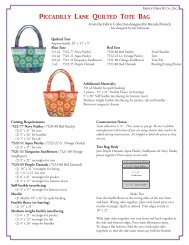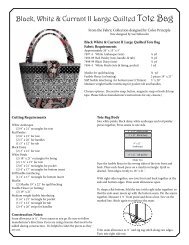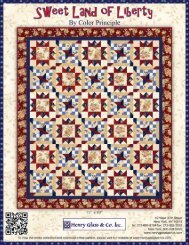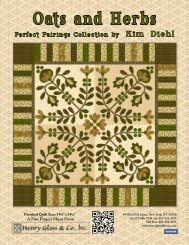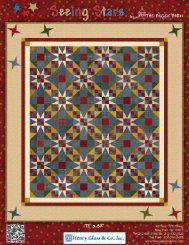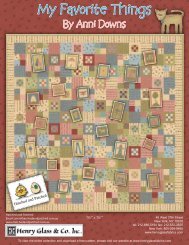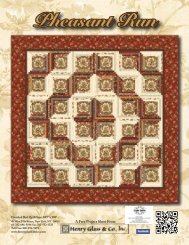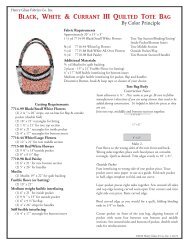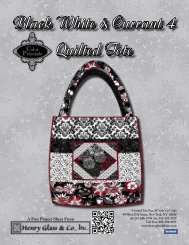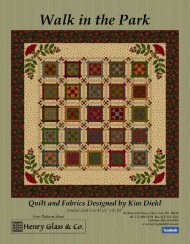Download Project PDF - Henry Glass & Co
Download Project PDF - Henry Glass & Co
Download Project PDF - Henry Glass & Co
You also want an ePaper? Increase the reach of your titles
YUMPU automatically turns print PDFs into web optimized ePapers that Google loves.
Autumn Festival<br />
Cutting Instructions for the Table Topper<br />
Please note: all strips are cut across the width of<br />
the fabric from selvage edge to selvage edge.<br />
From the printed panel, cut:<br />
(1) 36½" strip. Recut into (1) 36½" x 36½" square.<br />
From the brown paisley, cut:<br />
(2) 2¾" strips. Recut into (16) 2¾" x 5" pieces.<br />
From the cream paisley, cut:<br />
(5) 6" strips.<br />
From the gold tonal, cut:<br />
(3) 2¾" strips. Recut into (32) 2¾" x 2¾" squares.<br />
From the rust tonal, cut:<br />
(4) 2¾" strips. Recut into (32) 2¾" x 5" pieces.<br />
(6) 2¼" strips for the binding.<br />
From EACH of the green tonal and blue damask, cut:<br />
(2) 2¾" strips. Recut into (16) 2¾" x 2¾" squares.<br />
From the brown damask, cut:<br />
(3) 2¾" strips. Recut into (32) 2¾" x 2¾" squares.<br />
(4) 2" strips.<br />
From the cream damask, cut:<br />
(9) 2¾" strips. Recut into (32) 2¾" x 5" pieces and<br />
(64) 2¾" x 2¾" squares.<br />
(4) 2" strips.<br />
From the rust paisley, cut:<br />
(5) 6" strips.<br />
(2) 2¾" strips. Recut into (16) 2¾" x 5" pieces.<br />
Sewing Instructions for the Table Topper<br />
All seams are sewn using 1/4" seam allowance with<br />
pieces held right sides together and raw edges even.<br />
1. Draw diagonal lines on the wrong sides of 2¾" gold tonal<br />
and blue damask squares. Right sides together, layer the marked<br />
squares on opposite ends of a 2¾" x 5" cream damask piece,<br />
noting orientation. Stitch on the marked lines. Trim 1/4" beyond<br />
the seam lines and press the resulting triangles out to make the<br />
unit shown. Repeat to make a second identical unit. Repeat this<br />
procedure to make (2) similar units substituting green tonal<br />
squares for the blue damask squares.<br />
2. Draw a diagonal line on the wrong side of a 2¾" cream<br />
damask square. Right sides together, layer the marked square<br />
on one end of a 2¾" x 5" rust paisley piece, noting orientation.<br />
Stitch on the marked line. Trim 1/4" beyond the seam line and<br />
press the resulting cream triangle out to make the unit shown.<br />
Repeat to make a second identical unit. Repeat this procedure to<br />
make (2) similar units substituting 2¾" x 5" brown paisley pieces<br />
for the rust paisley pieces.<br />
3. Arrange the units made in steps 1 and 2 as shown, noting<br />
orientation. Stitch the units into pairs. Sew the pairs together to<br />
make (1) block measuring 9½" x 9½" from raw edge to raw edge.<br />
Cutting Instructions for the Tablecloth<br />
Page 1<br />
4. Repeat steps 1-3 to make a total of (8) pinwheel blocks.<br />
5. Stitch together (2) 2¾" cream damask and (2) 2¾" brown<br />
damask squares to make (1) four-patch block center as shown.<br />
Stitch 2¾" x 5" rust tonal pieces to the left and right sides of<br />
the four-patch. Stitch 2¾" cream and brown damask squares to<br />
opposite ends of a 2¾" x 5" rust tonal piece. Repeat to make a<br />
second unit. Stitch these units and the four-patch unit together<br />
as shown, noting orientation, to complete one chain block<br />
measuring 9½" x 9½" from raw edge to raw edge. Repeat to<br />
make a total of (8) identical blocks.<br />
6. Arrange the pinwheel blocks and chain blocks into (4) rows<br />
with (4) blocks in each row, alternating the two types of blocks<br />
and noting the orientation of each block. Stitch the blocks into<br />
rows. Sew the rows together to complete the quilt center.<br />
7. Trim (2) 2" brown damask strips to 36½". Stitch the trimmed<br />
strips to the left and right sides of the quilt center. Trim (2) 2"<br />
brown damask strips to 39½". Sew these strips to the top and<br />
bottom of the quilt top.<br />
8. Trim (2) 6" cream paisley strips to 39½". Stitch the trimmed<br />
strips to the left and right sides of the quilt top. Trim the<br />
selvages form the (3) remaining 6" cream paisley strips. Sew the<br />
strips together end to end to make a long 6" strip. From this<br />
long strip, cut (2) 50½" lengths. Sew these lengths to the top and<br />
bottom of the quilt top.<br />
9. Trim (2) 2" cream damask strips to 36½" and the remaining<br />
(2) 2" strips to 39½". Stitch the shorter strips to the left and<br />
right sides of the 36½" printed panel square. Sew the longer<br />
strips to the top and bottom of the square.<br />
10. Trim (2) 6" rust paisley strips to 39½". Stitch the trimmed<br />
strips to the left and right sides of the printed square unit. Trim<br />
the selvages form the (3) remaining 6" rust paisley strips. Sew<br />
the strips together end to end to make a long 6" strip. From this<br />
long strip, cut (2) 50½" lengths. Sew these lengths to the top<br />
and bottom of the printed square unit to complete the pieced<br />
backing.<br />
11. Layer the completed quilt top and the pieced backing with<br />
batting and quilt as desired. Bind the finished table topper using<br />
the 2¼" rust tonal strips.<br />
Please note: all strips are cut across the width of the fabric from selvage<br />
edge to selvage edge except for the printed panel strips..<br />
From the printed panel, cut:<br />
(4) lengthwise strips 10" wide x length of fabric, with a set of<br />
printed building motifs centered in each cut strip.<br />
From the cream damask, cut:<br />
(1) piece 40½" wide x 60½" long.<br />
From the blue paisley, cut:<br />
(9) 1½" strips.



